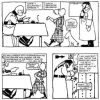
MAKING MY OWN COMICS, PART TWO!
Making Comics, Part One
Making Comics, Part Two
Making Comics, Part Three
Making Comics, Part Four
Making Comics, Part Five: Motion Comics
Time to start making my own comics, by my self. Everything you see on these pages is an original work, copyright me, Sam Battin.
All right, here's the number two in this series that explains the important work of making comics. This time, I've made a video and put it up on the You Tubes!
As you can see, it doesn't take me very long at all to ink a page. That's because the majority of the stuff I do is tracing over the pencils. Rarely, I will use a brush to make large areas of black, for the most part, I use the computer to do that sort of stuff.
The main problem I have with inking is that there's no way to undo a mistake besides using white out or, in some instances, throwing the entire page away and cursing at it. Using a computer allows me to use the Ctrl + Z feature to undo any fuck-ups I might happen to make. At the same time, though, I am aware that a line inked on bristol board looks different than a line drawn virtually that changes pixels from one color to another. I ink on paper because that's what I'm used to.
I've been doing comics since... well, the earliest recorded instance of me doing comics was when I was 13 years old, back in 1983. Our school's student poetry collection (published quarterly) that year contained a comic of perhaps 10 or 20 pages. It was a parody of James Bond that included one of the British kids who attended the school.
Being an American, I was no stranger to comics. I'd read Marvels and DCs before (as well as a couple of extremely dirty underground comics, which is another story), but I remember really enjoying the home-spun comic by one of the school students. While reading the comic, eventually the thought came to me: You don't need to be an adult to do comics.
So I did my first comics around this age. Unfortunately, or perhaps fortunately, I no longer know where they are. So I was 14, 15, just doing comics occasionally. I didn't do them every day. When I got to be 23 & had Mr. Dudak as a roommate, I got the idea in my head: I can do comics for a living.
Of course, having thought that, I wasn't very good at all. For example, here's a page of comics from when I was 23 years old. Yes it's true, you look back on your early work and shudder:

|
A Vague Plan
I was conscious of the fact that my skill in drawing wasn't where it needed to be for me to make a living at doing comics. There was a value to me, however, in making comics and showing them to my friends. So I figured to myself, at age 25, that I wouldn't quit my day job, I'd learn how to draw for the next 1.5 decades, and then at age 40 I could emerge as a full professional comic guy.
The important thing is to keep going, and keep trying to do better. I mean, have you ever heard of Herge's Tintin? Yeah, he's all famous now, but let's take a look at his stuff from very early in his career:

|
All right, now is there anything there, in an age 23 Herge, that would suggest he'd eventually do stuff like this?

|
Looking at it, I'd say yeah, his talent was evident. At age 23 he had an instinct for presenting a clear picture, clever dialog, and strong characterization as well as good postures... Erg.
Some doors are better left unopened. Forget it. Don't look back. Your best work is always in front of you, or so I've heard. Keep trying and be honest with yourself, even if looking at your early work makes you nauseous.
Hang on. If this is how I drew at age 23, then does this mean...

|
NEXT: Go read Making Comic Books Part Three or go back and read Making Comic Books Part One!

